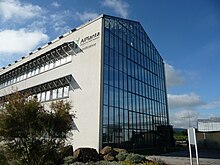Mußbacher donkey skin
The Mußbacher Eselshaut vineyard is a single location in Mußbach an der Weinstrasse , an old Palatinate winegrowing town located in the hilly region of the Mittelhaardt-Deutsche Weinstrasse wine-growing region and incorporated into Neustadt an der Weinstrasse in 1969 . The donkey skin as a Palatinate vineyard is now part of the Gimmeldinger sea spider, which has been upgraded to a large location .
geography
Geographical location
The vineyard area covers almost 300 hectares and extends in two parts, which are interrupted by the residential development, from southwest to northeast.
The smaller southwest part lies on both sides of the state road 516, which connects Mußbach with the core town of Neustadt. In the south it is bordered by the B 38 , in the west almost entirely by Kreisstraße 21, which leads from the suburb of Gimmeldingen to Neustadt. The larger northeast part lies between the L 516 (Mußbach– Deidesheim ) in the west and the L 532 (Mußbach– Haßloch ) in the south and is crossed in the northeast by the L 519 (Mußbach– Meckenheim ). The Service Center Rural Areas (DLR) Rheinpfalz is located on its south-eastern edge .
Climate and soil
2 km west of Mußbach shields the 554 m above sea level. NHN high Weinbiet, with the prevailing wind direction southwest or west, in its leeward area , protects against excessive rainfall. The donkey skin has dry, mostly sandy soils, where rapid warming is guaranteed. They rise slightly from south-east to north-west and thus also have a favorable angle to the morning sun. This fact extends the time in which the grapes are exposed to the sun during the day and can form sugar . The slope also means that on frosty spring nights, cold air masses flow off to the Rhine plain and the vines usually do not freeze .
Surname
The name Eselshaut is traced back to Middle High German "houwet" or "Höuwet" for haymaking and indicates the meadows where hay was made for the donkeys kept in the stable .
The donkey is omnipresent in Mußbach to this day:
- At the eastern entrance to the village, a vertical barrel bottom shows the image of a donkey.
- The sculpture of a donkey was placed on Provenceplatz .
- The former main street is called An der Eselshaut .
- The painter and sculptor Fritz Wiedemann restored an old winegrower's house in the 1960s and created a wine tavern called Eselsburg in it.
- The donkey skin festival on the grounds of the Herrenhof , which takes place on two weekends in June / July, has long since replaced the kerwe as the most important festival in the area.
- During parades, a living donkey is carried along on a rope.
More vineyards
Other - smaller - individual locations in Mußbach are Bischofsweg, Glockenzehnt, Johannitergarten, Kurfürst, Spiegel, Schlössel, Mandelring and Mandelgarten .
Web links
- Location map of the donkey skin on vineyard info
- Operator website of the Eselshautfest (annual ad hoc update)
Individual evidence
- ↑ Mußbach. City of Neustadt an der Weinstrasse, accessed on February 15, 2019 .
- ↑ Rudolf Steffens: Wine and viticulture in the mirror of language . In: Sigrid Hirbodian, Tjark Wegner (ed.): Wine in Württemberg (= Landeskundig . Volume 3 ). Jan Thorbecke Verlag, Ostfildern 2017, ISBN 978-3-7995-2072-0 , p. 203-235, esp. Pp. 207 and 210 .
- ↑ Carina Zweck, Manfred Halfer: From the Musehelde to the mouse cave . The Palatinate vineyards. Origin and interpretation of their names. Deidesheim 1992, p. 17 .


